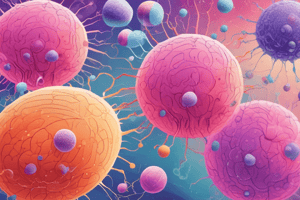Podcast
Questions and Answers
What is one of the main goals of cancer treatment?
What is one of the main goals of cancer treatment?
- To manage symptoms and improve quality of life (correct)
- To consistently apply a single type of treatment
- To completely eliminate all symptoms
- To minimize the patient's contact with healthcare providers
How can regular screenings contribute to cancer prevention?
How can regular screenings contribute to cancer prevention?
- They can detect cancer when it's more treatable. (correct)
- They instantly cure any detected cancer.
- They eliminate the need for a healthy lifestyle.
- They enable the use of harsher treatments.
Which of the following is NOT considered a common treatment modality for cancer?
Which of the following is NOT considered a common treatment modality for cancer?
- Radiation therapy
- Hormone therapy
- Immunotherapy
- Homeopathy (correct)
What can lab tests like blood cell counts indicate in cancer patients?
What can lab tests like blood cell counts indicate in cancer patients?
Which lifestyle change is NOT recommended for reducing cancer risk?
Which lifestyle change is NOT recommended for reducing cancer risk?
What distinguishes malignant tumors from benign tumors?
What distinguishes malignant tumors from benign tumors?
Which of the following is NOT a recognized cause of cancer?
Which of the following is NOT a recognized cause of cancer?
What is a key characteristic of benign tumors?
What is a key characteristic of benign tumors?
Which of these statements about cancer development is true?
Which of these statements about cancer development is true?
How can cancer spread within the body?
How can cancer spread within the body?
Which factor is a lifestyle risk for developing cancer?
Which factor is a lifestyle risk for developing cancer?
What role do genetic mutations play in cancer?
What role do genetic mutations play in cancer?
Which diagnostic method is commonly used to confirm cancer?
Which diagnostic method is commonly used to confirm cancer?
Flashcards
What are blood cell counts used for in cancer?
What are blood cell counts used for in cancer?
Lab tests that can provide additional information about cancer progression, response to treatment, or its potential impact on different bodily systems.
What are the common cancer treatment modalities?
What are the common cancer treatment modalities?
Common treatment options include surgery, radiation therapy, chemotherapy, targeted therapies, immunotherapy, and hormone therapy.
What is the goal of cancer treatment?
What is the goal of cancer treatment?
Treatments for cancer aim to remove or destroy cancer cells, shrink tumors, and reduce the spread of cancer.
What are some other aspects of successful cancer treatment?
What are some other aspects of successful cancer treatment?
Signup and view all the flashcards
How can lifestyle choices impact cancer risk?
How can lifestyle choices impact cancer risk?
Signup and view all the flashcards
Cancer
Cancer
Signup and view all the flashcards
Benign Tumors
Benign Tumors
Signup and view all the flashcards
Malignant Tumors
Malignant Tumors
Signup and view all the flashcards
Metastasis
Metastasis
Signup and view all the flashcards
Carcinogens
Carcinogens
Signup and view all the flashcards
Lifestyle Factors
Lifestyle Factors
Signup and view all the flashcards
Cancer Progression
Cancer Progression
Signup and view all the flashcards
Cancer Diagnosis
Cancer Diagnosis
Signup and view all the flashcards
Study Notes
Cancer Overview
- Cancer is a group of diseases characterized by uncontrolled cell growth.
- It arises from failures in mechanisms controlling cell division, growth, and death.
- Uncontrolled abnormal cell growth forms tumors, which can be benign (non-cancerous) or malignant (cancerous).
- Malignant tumors invade surrounding tissues and may metastasize (spread) to other body parts.
- Cancers vary based on tissue/organ origin, including lung, breast, colon, and leukemia.
- Cancer encompasses diverse diseases with differing causes, characteristics, and treatments.
Causes of Cancer
- Genetic mutations (inherited or acquired) increase cancer risk.
- Exposure to carcinogens (chemicals, radiation, certain viruses) contributes to cancer.
- Lifestyle factors (smoking, diet, inactivity, obesity) elevate cancer risk.
- Certain chronic infections increase cancer risk in some populations.
Types of Cancer and Development
- Cancer development is a multi-step process, often involving multiple genetic mutations over many years.
- Different cancers have varying properties regarding cell origin, growth rate, and treatment response.
- Some cancers progress slowly, others rapidly.
- Specific mutations cause uncontrolled cell growth/division, beginning tumor formation.
Tumor Characteristics
- Benign tumors are typically encapsulated and do not invade other tissues. They can cause issues if they grow large and compress organs/vessels.
- Malignant tumors lack encapsulation, are invasive, exhibiting abnormal cell shapes, faster growth, and unusual behaviors.
- Metastasis, the spread of cancerous cells to distant sites via the circulatory or lymphatic systems, is a hallmark of malignant tumors.
Cancer Diagnosis
- Diagnosis uses a combination of physical exams, imaging (X-rays, CT, MRI), biopsies, and blood tests.
- Blood tests (like complete blood counts) provide information regarding cancer progression, treatment response, and overall impact on the body.
Cancer Treatment
- Treatment options depend on the cancer type, stage, patient's health, and choose from various options, including surgery, radiation, chemotherapy, targeted therapies, immunotherapy, and hormone therapy.
- The goal is to remove/destroy cancer cells, shrink tumors, reduce spread, manage symptoms, and improve quality of life.
Cancer Prevention
- A healthy lifestyle (balanced diet, regular exercise, avoiding tobacco) reduces cancer risk.
- Regular screenings (e.g., mammograms, colonoscopies) detect cancer early, improving treatment outcomes.
- Reduced exposure to known carcinogens is essential for prevention.
Studying That Suits You
Use AI to generate personalized quizzes and flashcards to suit your learning preferences.



